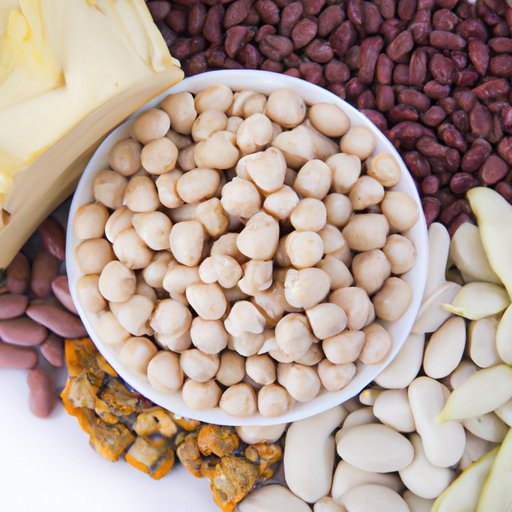Introduction
Protein is an important macronutrient that plays a vital role in our bodies. It helps build and repair muscle tissue, as well as produce enzymes and hormones. To maintain good health, it’s essential to get enough protein in our diets. But how much exactly do we need? And what are the best ways to make sure we’re eating enough? In this article, we’ll explore the recommended dietary allowance for protein, provide tips for incorporating protein-rich foods into your diet, discuss the benefits of taking protein powder, and much more.
Research the Recommended Dietary Allowance for Protein
The Recommended Dietary Allowance (RDA) for protein is 0.8 grams of protein per kilogram of body weight, or 0.36 grams per pound. According to the National Academy of Medicine, this amount is sufficient to meet the needs of 97.5 percent of healthy individuals. However, there are certain age groups that require more protein than others. The RDA for infants is 1.52 grams of protein per kilogram of body weight, while the RDA for adolescents aged 14 to 18 is 1.34 grams per kilogram of body weight.
Eat Protein-Rich Foods at Every Meal
The easiest way to ensure you’re getting enough protein is to focus on eating protein-rich foods at every meal. Examples of such foods include chicken, turkey, fish, eggs, nuts, seeds, beans, lentils, and tofu. You can also find protein in dairy products like milk, yogurt, and cheese. Aim to include at least one source of protein with each meal and snack.
Here are some tips for incorporating protein-rich foods into your diet:
- Add nuts and seeds to salads, oatmeal, and yogurt.
- Swap out white rice for quinoa or lentils.
- Snack on hard-boiled eggs, string cheese, or Greek yogurt.
- Opt for lean proteins such as skinless chicken breast and wild-caught salmon.
- Make veggie burgers with black beans and quinoa.

Use Protein Powder as a Supplement
If you’re looking for an easy way to get more protein in your diet, consider using protein powder as a supplement. There are a variety of types available, including whey, casein, egg, and plant-based proteins. Protein powder can be added to smoothies, shakes, or baked goods for an extra boost of protein.
Some of the benefits of taking protein powder include:
- It’s convenient and easy to use.
- It helps build and repair muscle tissue.
- It can help promote weight loss by making you feel fuller for longer.
- It can help reduce cravings for unhealthy snacks.
When it comes to how much protein powder you should take, it depends on your individual needs. The American College of Sports Medicine recommends taking 0.14 to 0.23 grams of protein per pound of body weight per day. So if you weigh 150 pounds, you should aim to consume 21 to 34 grams of protein from powder each day.
Get Creative with High-Protein Snacks
Snacking is a great way to get more protein into your diet. Instead of reaching for chips or candy, opt for high-protein snacks like nut butter on celery sticks, hard-boiled eggs, tuna salad, or edamame. You can also make your own protein bars with ingredients like oats, peanut butter, honey, and protein powder.
Here are some ideas for making delicious high-protein snacks:
- Mix together cottage cheese, diced tomatoes, and basil.
- Top toast with nut butter and banana slices.
- Stuff bell peppers with ground turkey and quinoa.
- Make a smoothie with almond milk, frozen berries, and protein powder.
- Bake chickpeas with olive oil, salt, and pepper.
Add Protein-Rich Toppings to Salads and Soups
Salads and soups are often low in protein, so adding protein-rich toppings can help boost their nutritional content. Examples of protein-rich toppings include grilled chicken, hard-boiled eggs, canned tuna, edamame, sunflower seeds, and hemp hearts. Not only will these toppings add flavor and texture to your dishes, but they’ll also help keep you feeling full and satisfied.
Here are some benefits of adding protein-rich toppings to salads and soups:
- They provide essential amino acids.
- They help regulate blood sugar levels.
- They help maintain muscle mass and strength.
- They can help reduce appetite and cravings.

Incorporate Legumes into Your Diet
Legumes are another great source of protein. They’re also packed with fiber, vitamins, minerals, and antioxidants. Examples of legumes include beans, peas, lentils, and peanuts. You can incorporate them into your diet by adding them to salads, soups, stews, and casseroles. They can also be used to make dips and spreads.
Here are some of the health benefits of eating legumes:
- They’re rich in fiber, which can help lower cholesterol levels.
- They’re a good source of iron, zinc, and folate.
- They can help reduce the risk of heart disease and type 2 diabetes.
- They’re low in calories and fat, making them a great option for weight loss.
Conclusion
Protein is an essential macronutrient for optimal health. To ensure you’re getting enough protein, research the recommended dietary allowance for protein, eat protein-rich foods at every meal, consider taking protein powder as a supplement, get creative with high-protein snacks, add protein-rich toppings to salads and soups, and incorporate legumes into your diet. By following these tips, you’ll be on your way to meeting your daily protein needs.
(Note: Is this article not meeting your expectations? Do you have knowledge or insights to share? Unlock new opportunities and expand your reach by joining our authors team. Click Registration to join us and share your expertise with our readers.)
